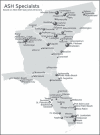Impacting population cardiovascular health through a community-based practice network: update on an ASH-supported collaborative
- PMID: 21806763
- PMCID: PMC3149840
- DOI: 10.1111/j.1751-7176.2011.00491.x
Impacting population cardiovascular health through a community-based practice network: update on an ASH-supported collaborative
Abstract
The Hypertension Initiative began in 1999 to help transition South Carolina from a leader in cardiovascular disease (CVD) to a model of heart and vascular health. Goals were to reduce heart disease and stroke by 50% by promoting healthy lifestyles and access to effective care and medications. Continuing medical education was used to train providers, encourage physicians to become American Society of Hypertension (ASH)-certified hypertension specialists and recruit practices into the community-based practice network (CBPN). Practice data audit with provider specific feedback is a key quality improvement tool. With ASH support, the CBPN has grown to 197 practices with approximately 1.6 million patients (approximately 700,000 hypertensives). Clinical data are obtained from electronic health records and quarterly provider feedback reports are generated. Hypertension, hypercholesterolemia, and diabetes control rose and South Carolina's ranking improved from 51st to 35th in CVD mortality from 1995 to 2006. The Hypertension Initiative expanded to the Outpatient Quality Improvement Network (O'QUIN) to encompass comparative effectiveness research and other chronic diseases. Lessons learned include: trust enables success, addressing practice priorities powers participation, infrastructure support must be multilateral, and strategic planning identifies opportunities and pitfalls. A collaborative practice network is attainable that produces positive, sustainable, and growing impacts on cardiovascular and other chronic diseases.
© 2011 Wiley Periodicals, Inc.
Figures



Similar articles
-
Formation of community-based hypertension practice networks: success, obstacles, and lessons learned.J Clin Hypertens (Greenwich). 2014 Jun;16(6):393-7. doi: 10.1111/jch.12310. Epub 2014 Mar 26. J Clin Hypertens (Greenwich). 2014. PMID: 24666425 Free PMC article.
-
Cardiovascular risk factor control in communities--update from the ASH Carolinas-Georgia Chapter, the Hypertension Initiative, and the Community Physicians' Network.J Clin Hypertens (Greenwich). 2006 Dec;8(12):879-86. doi: 10.1111/j.1524-6175.2006.05677.x. J Clin Hypertens (Greenwich). 2006. PMID: 17170614 Free PMC article.
-
2003 update on the Hypertension Initiative of South Carolina. Bringing South Carolina from "worst to first" in cardiovascular health.J S C Med Assoc. 2003 Jun;99(6):157-61. J S C Med Assoc. 2003. PMID: 12886701
-
Community-based approaches to prevention and management of hypertension and cardiovascular disease.J Clin Hypertens (Greenwich). 2012 May;14(5):336-43. doi: 10.1111/j.1751-7176.2012.00622.x. Epub 2012 Apr 18. J Clin Hypertens (Greenwich). 2012. PMID: 22533661 Free PMC article. Review.
-
Prostate cancer disparities in South Carolina: early detection, special programs, and descriptive epidemiology.J S C Med Assoc. 2006 Aug;102(7):241-9. J S C Med Assoc. 2006. PMID: 17319238 Review.
Cited by
-
Formation of community-based hypertension practice networks: success, obstacles, and lessons learned.J Clin Hypertens (Greenwich). 2014 Jun;16(6):393-7. doi: 10.1111/jch.12310. Epub 2014 Mar 26. J Clin Hypertens (Greenwich). 2014. PMID: 24666425 Free PMC article.
-
Rationale for establishing a mechanism to increase reimbursement to hypertension specialists.J Clin Hypertens (Greenwich). 2013 Jun;15(6):397-403. doi: 10.1111/jch.12090. Epub 2013 Apr 11. J Clin Hypertens (Greenwich). 2013. PMID: 23730988 Free PMC article.
-
Impact of Implementing the 2013 ACC/AHA Cholesterol Guidelines on Vascular Events in a Statewide Community-Based Practice Registry.J Clin Hypertens (Greenwich). 2016 Jul;18(7):663-71. doi: 10.1111/jch.12727. Epub 2015 Nov 26. J Clin Hypertens (Greenwich). 2016. PMID: 26606899 Free PMC article.
-
[Drivers and scorecards to improve hypertension control in primary care practice: Recommendations from the HEARTS in the Americas Innovation GroupFactores impulsores y métodos de puntuación para mejorar el control de la hipertensión en la práctica clínica de la atención primaria: recomendaciones del grupo de innovación de HEARTS en las Américas].Rev Panam Salud Publica. 2022 May 10;46:e68. doi: 10.26633/RPSP.2022.68. eCollection 2022. Rev Panam Salud Publica. 2022. PMID: 35573115 Free PMC article. Portuguese.
-
A Medicaid Statewide Hypertension Quality Improvement Project: Initial Results.Cureus. 2023 Mar 14;15(3):e36132. doi: 10.7759/cureus.36132. eCollection 2023 Mar. Cureus. 2023. PMID: 37065351 Free PMC article.
References
-
- Nembhard I, Alexander J, Hoff T, Ramanujam R. Why does the quality of health care continue to lag? Insights from management research. Acad Manage J. 2009;23:24–42.
-
- Green L, Hickner J. A short history of primary care practice‐based research networks: from concept to essential research laboratories. J Am Board Fam Med. 2006;19:1–10. - PubMed
-
- Fagnan L, Morris C, Shipman S, et al. Characterizing a practice‐based research network: Oregon rural practice‐based research network (ORPRN) survey tools. J Am Board Fam Med. 2007;20:204–219. - PubMed
MeSH terms
Grants and funding
LinkOut - more resources
Full Text Sources
Medical
Research Materials
Miscellaneous

